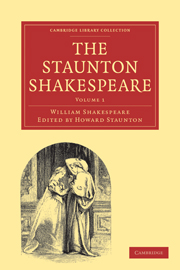Book contents
- Frontmatter
- Contents
- PREFACE
- SOME ACCOUNT OR THE LIFE OF SHAKESPEARE
- SHAKESPEARE'S WILL
- PRELIMINARY MATTER IN THE FOLIO OF 1623
- THE ADDRESS TO THE READER
- COMMENDATORY VERSES
- ADDENDA AND CORRIGENDA
- THE TWO GENTLEMEN OF VERONA
- LOVE'S LABOUR'S LOST
- THE COMEDY OF ERRORS
- ROMEO AND JULIET
- THE TAMING OF THE SHREW
- KING JOHN
- A MIDSUMMER NIGHT'S DREAM
- THE MERCHANT OF VENICE
- KING RICHARD THE SECOND
- THE FIRST PART OF KING HENRY THE FOURTH
- THE SECOND PART OF KING HENRY THE FOURTH
- THE MERRY WIVES OF WINDSOR
- MUCH ADO ABOUT NOTHING
MUCH ADO ABOUT NOTHING
Published online by Cambridge University Press: 29 August 2010
- Frontmatter
- Contents
- PREFACE
- SOME ACCOUNT OR THE LIFE OF SHAKESPEARE
- SHAKESPEARE'S WILL
- PRELIMINARY MATTER IN THE FOLIO OF 1623
- THE ADDRESS TO THE READER
- COMMENDATORY VERSES
- ADDENDA AND CORRIGENDA
- THE TWO GENTLEMEN OF VERONA
- LOVE'S LABOUR'S LOST
- THE COMEDY OF ERRORS
- ROMEO AND JULIET
- THE TAMING OF THE SHREW
- KING JOHN
- A MIDSUMMER NIGHT'S DREAM
- THE MERCHANT OF VENICE
- KING RICHARD THE SECOND
- THE FIRST PART OF KING HENRY THE FOURTH
- THE SECOND PART OF KING HENRY THE FOURTH
- THE MERRY WIVES OF WINDSOR
- MUCH ADO ABOUT NOTHING
Summary
The only edition of this comedy known before the folio 1623, is a quarto printed in 1600, entitled :— “Much adoe about Nothing, as it hath been sundrie times publikely acted by the right honourable the Lord Chamberlaine his seruants. Written by William Shakespeare. London Printed by V. S. for Andrew Wise and William Aspley, 1600.” It is supposed originally to have been acted under the title of “Benedick and Beatrix,” and, from being unnoticed by Meres, to have been written not earlier than 1598.
The serious incidents of his plot, some writers conjecture, Shakespeare derived from the story of Ariodante and Geneura, in Ariosto's Orlando Furioso, which, in 1582-3, was made the subject of dramatic representation, and played before Queen Elizabeth by “Mulcaster's children,” that is, the children of St. Paul's school, and of which an English translation by Sir John Harrington, Elizabeth's “merry poet,” and godson, was published in 1591. Others, with more probability, believe the source from whence he took them was some now extinct version of Bandello's twenty-second novel, “Como il S. Timbreo di Cardona, essendo col Re Piero d'Aragona in Messina, s'innamora, di Fenicia Leonata: e i varii fortunevoli accidenti, che avvennero prima che per moglie la prendesse.” In Bandello's story the scene, like that of the comedy, is laid at Messina; the name of the slandered lady's father is the same, Lionato, or Leonato; and the friend of her lover is Don Piero, or Pedro.
- Type
- Chapter
- Information
- The Staunton Shakespeare , pp. 691 - 748Publisher: Cambridge University PressPrint publication year: 2009First published in: 1858

